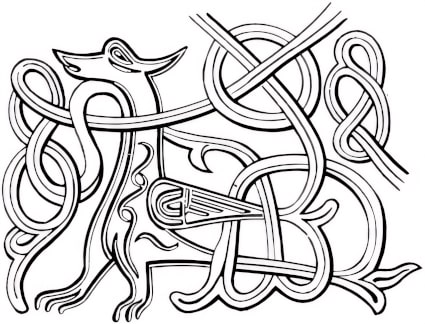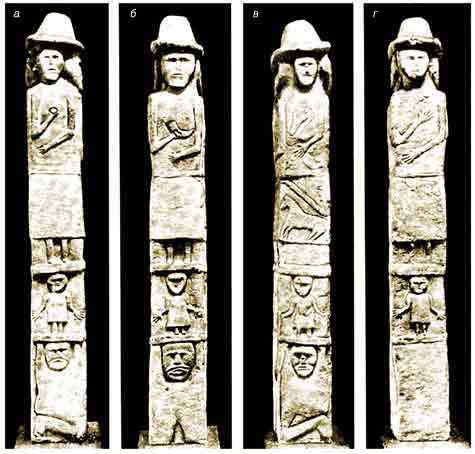Maybe it’s because I recently watched Conclave, but I’ve lately been interested in researching the hierarchy and religious orders of the Catholic church. Many RPG and fantasy churches, while ostensibly polytheistic religions, are really thinly veiled adaptions of Roman Catholicism. As a Protestant, a lot of the pomp and ceremony of Catholicism is both intriguing and opaque, hence the need for research on my part. I was particularly wondering about the differences between the various religious orders, having encountered them again in Shadowrun lore. Since I couldn’t find all of the information in one place, I thought a little guide might be useful to other non-Catholics who want to wrap their head around some of these concepts. Again, disclaimer, I am not Catholic, even by upbringing, so if you notice any errors on my part, please let me know and I’ll gladly correct them!
Conveniently, the history of religious orders is already alphabetized, so we’ll tackle them roughly in that order! First, a bit of definition time: the religious orders are groups within the church that are outside the normal hierarchy of the church. A priest reports to the bishop of their diocese (a geographic territory of the church), and the bishops in turn report to the archbishop of their archdiocese, who in turn reports to the Pope. Members of religious orders (through most of their history, anyway) are independent of this scheme. They can still be tied to a location like an abbey or a monastery, but they don’t have to be. Their activities are structured by a rule, literally the rules that they need to follow in addition to the vows a priest would take.
| ORDER | TYPE | COLORS | KNOWN FOR… |
|---|---|---|---|
| Augustinians | canons regular / mendicant (friars) | black or white | prestige & variety |
| Benedictines | monastic (monks) | Black Monks | scriptoriums |
| Cluniacs | monastic (monks) | black | art |
| Cistercians | monastic (monks) | White Monks | artisan goods |
| Carthusians | monastic (monks) | white | silence & isolation |
| Carmelites | mendicant (friars) | White Friars | miracles & visions |
| Dominicans | mendicant (friars) | Black Friars | theology |
| Franciscans | mendicant (friars) | Brown / Grey Friars | loving animals |
| Hospitalers | military | white on red | naval power |
| Templars | military | red on white | conspiracy theories o__O |
| Trinitarians | mendicant (friars) | Red Friars | freeing captives |
A is for Augustinians. They’re probably the most confusing order to me because they’re not actually a single group, but a lot of related groups. They trace their origin to the rule of St. Augustine who lived in North Africa during the waning days of the Roman Empire. The rule of St. Augustine was literally the rules for the clergy within his church, but it became popular throughout Christendom. After Christianity had become the state religion of the Roman Empire, some people sought ways to attain greater holiness through lives of asceticism, isolation, and contemplation. Rules like those of St. Augustine were popular with the church because they harnessed these various holy urges into forms that were compatible with doctrine to hopefully avoid heresies and schisms.
Some of the early Augustinians were hermits (and we’ll revisit them later), but the early structured Augustinians are what the church calls Canons Regular, something between a normal clergy member and the monastic groups we’ll get to next. Canon was a term for clergy who lived together in a community, and regular literally just means regulated by a rule.
In the year 529, during the period we’d usually call Late Antiquity rather than medieval, St. Benedict of Nursia made his own rule and thus founded the Benedictines. This was the first truly monastic order of the church: that is, a group that lives separate from society to lead lives of contemplation. Each monastery was a self-sufficient community, but they would become famous in the Middle Ages particularly for their scriptoriums, where ancient documents were copied and preserved. The Benedictines are also known as Black Monks for the color of their robes.
Once we get into the Middle Ages proper, several Benedictine groups tried to reform their practices and became splinter groups. The largest and most prominent of these were the Cluniacs, started in Cluny Abbey in France and the Cistercians, who started in Cîteaux Abbey (cîteaux being the French for cistern). The Cluniac reforms of 910 mainly aimed at freeing abbeys from control of local nobles, because these nobles tended to encourage some laxity in monastic schedules in order to make the abbeys nice retirement homes for themselves. Cluniacs seem to also have been particularly dedicated to artistic endeavors alongside their other monastic activities.
The Cistercians went even further in 1098, eschewing Benedictine’s emphasis on learning for hard work. Though Benedictines live humble lives, they look lavish in comparison to the Cistercians. Between all their manual labor and their humble diets, the Cistercians produced a lot of surplus artisanal goods like cheeses. The Trappists, known for their brewing, are an offshoot of the Cistercians from the 1600s. The Cistercians are sometimes called White Monks for their garments.
The last major medieval monastic order was not an offshoot of the Benedictines, but it also happened to start with a C: the Carthusians. The Carthusians, founded contemporaneously with the Cistercians, were more about the isolation part of monasticism, their abbeys are small and remote. They also sometimes take vows of silence, which are not so common in the other major orders.
As long as we’re sticking with the alphabet theme, we can also mention the Carmelites. Their history is a bit harder to pin down, but they were probably founded close to a century after the Cistercians around Mt. Carmel in the holy land. Though they focus on a contemplative life like monks, the carmelites are not really a monastic order, and the early members would be considered eremetic, that is, hermits. The Carmelites are also well known for their religious visions.
In the early 1200s, we see the rise of the mendicant orders, the Dominicans and the Franciscans. Whereas monastic groups live together in relative isolation in a monastery or abbey, mendicants travel among the flock, living by alms. They are not monks, but are properly referred to as friars (think Friar Tuck). The Dominicans are more properly the Order of Preachers, but called Dominicans after St. Dominic, their founder. They focus on intellectual activities, and are well known even today for making theological arguments; probably the most famous medieval philosopher, Thomas Aquinas, was a Dominican. The Dominicans were specifically founded to try to combat the Albiginsian heresy in southern France through persuasion rather than violent crusade, with mixed results. Due to their habit, the Dominicans are sometimes called Black Friars.
The Franciscans were founded by, if you couldn’t guess, St. Francis of Assisi! Sort of similar to the split between Benedictines and Cistercians, who alternately focused on intellectual activities and manual labor, the Franciscans contrast the Dominicans in being more about helping the poor than pondering theology. Character-wise, modern Franciscans seem to be known for being laid back compared to Dominicans, the kind of people you want to watch your pets (it’s no coincidence St. Francis is always pictured surrounded by animals)! But they were still a religious order, and their insistence on the doctrine of the poverty of Christ caused a major controversy in the medieval church (see, for instance the contrast between Benedictines and Franciscans in the novel The Name of the Rose). Franciscans are sometimes called the Grey Friars, even though only some of them wear grey and most pop culture representations have them in brown (again, think Friar Tuck).

In the 1200s, as mendicant orders were springing up everywhere, the Pope tried to put his foot down and stop things from getting out of hand. At the Council of Lyons, the majority of the mendicant orders were suppressed. As the biggest and most prestigious, the Dominicans and Franciscans were allowed to remain. The Carmelites, originally eremetic, transitioned into a mendicant order (the White Friars) as it spread to Europe and was also spared. The last major order that was allowed was created as a merger of several smaller orders that followed the Augustinian rule, and was so dubbed the Augustinians (I told you we’d get back to them!) There was actually some friction when the relics of St. Augustine were given to the join care of the two Augustinians, and the Canons Regular had to share their lodgings with the Austin Friars (as they were also called). Whereas many of the other orders have a certain character associated with them, the Augustinians, as a hodgepodge, are a bit harder to pin down. They are definitely prestigious; the Papal Sacristan who, among other things, is the one to take the Pope’s confession, is always an Augustinian. The Augistinians seem closest in character to the Dominicans. Shadowrun put its modern Augistinians in charge of the Papal archives (including their Matrix hookup), and I’m not sure if it’s due to the order’s prominence in high ranking clergy, the fact that they founded one of the first public libraries in Europe, or some other reason.
That covers the major medieval orders, both monastic and mendicant, but there were other smaller orders as well, like the Trinitarians (Red Friars) whose mission was to help ransom Christians who had been captured by Muslim pirates in the Mediterranean. (This happened a lot, actually. Post-Crusades, there continued to be an irregular war in the Mediterranean carried out mostly by pirates. The popular imagination puts galley slaves in the ancient world of Greece and Rome, but they weren’t so common then as they were in the Early Modern period. They even show up in Don Quixote!)
We got from A to F (skipping E), but the ordering breaks down if we consider the military orders as the Hospitalers and Templars were actually founded before the Dominicans. These guys were named for the headquarters, the Hospital of St. John and the Temple of Solomon in Jerusalem, respectively. These orders were established not to turn monks into knights but to turn knights into something more akin to monks, it’s worth mentioning. I don’t want to spend a lot of time on the military order because they’re rather more famous in pop culture (even if a lot of it is hyperbole and fantasy), but did you know that while the Templars were famously suppressed, the Knights of St. John lived on? After the fall of the Crusader states, they operated out of Rhodes for a while and then Malta. They had a major fleet that pirated in the eastern Mediterranean (or privateered, depending on your point of view) and participated in the Battle of Lepanto against the Ottomon Empire. Their military power wasn’t really taken out until the Napoleonic period. The order still exists today as a Sovereign Military Order of Malta, but they now are involved in charitable works rather than warfare.
Indeed, most of these orders still exist today. Though they may no longer play the outsized role they did in medieval society, some Benedictines now illuminate websites (link) rather than manuscripts. In any case, I hope this little data dump is interesting and helps you in your own worldbuilding projects.


















